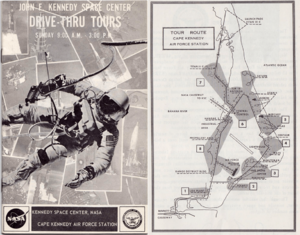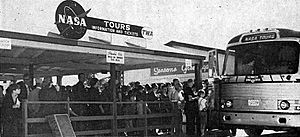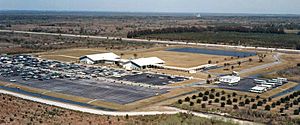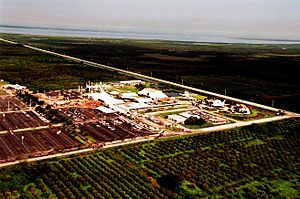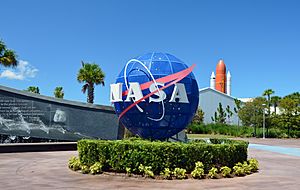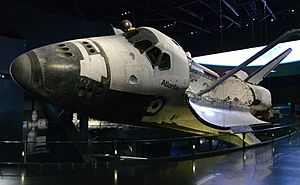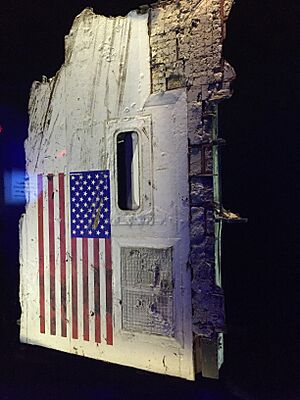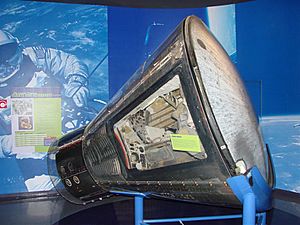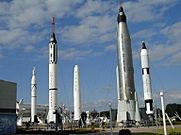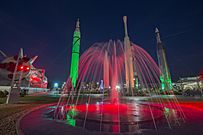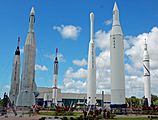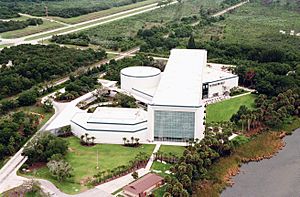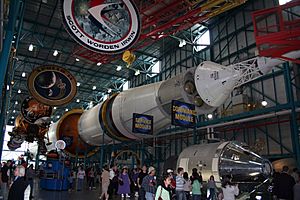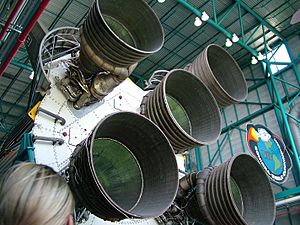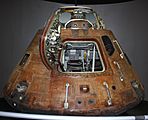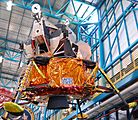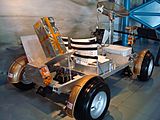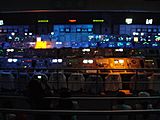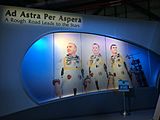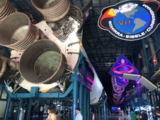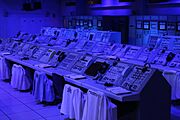Kennedy Space Center Visitor Complex facts for kids
| Previously known as Spaceport USA, Visitor Information Complex | |
 |
|
| Location | Merritt Island, Florida, United States |
|---|---|
| Coordinates | 28°31′24″N 80°40′55″W / 28.5233°N 80.6819°W |
| Opened | August 1, 1967 |
| Owner | NASA |
| Operated by | Delaware North Companies |
| Theme | NASA and space exploration |
| Operating season | Open Year-round |
| Attendance | 1.7 million |
| Area | 42 acres (17 ha) |
| Website | http://www.kennedyspacecenter.com |
The Kennedy Space Center Visitor Complex is a special place where you can learn all about NASA and space travel. It's located at NASA's Kennedy Space Center in Merritt Island, Florida. Here, you can see amazing exhibits, real historic spacecraft, and even items that astronauts used.
The complex has shows, two IMAX theaters, and bus tours that take you around the spaceport. One of the most popular exhibits is the "Space Shuttle Atlantis." It features the actual Atlantis orbiter and a ride called the Shuttle Launch Experience. This ride makes you feel like you're launching into space! You can also try astronaut training activities, like a multi-axial chair or a Mars Base simulator. Plus, you can often hear talks from real NASA astronauts. A bus tour, which is part of your ticket, takes you to the separate Apollo/Saturn V Center. In 2016, about 1.7 million people visited the complex.
Contents
- Exploring the History of Space Travel
- Amazing Attractions to Explore
- Space Shuttle Atlantis Exhibit
- Shuttle Launch Experience
- Heroes & Legends Exhibit
- Rocket Garden: A Collection of Space Giants
- Gateway: The Deep Space Launch Complex
- Apollo/Saturn V Center: A Giant Rocket Story
- Journey to Mars: Explorers Wanted
- NASA Now: Current Spacecraft
- Space Mirror Memorial
- Planet Play: Fun for Younger Explorers
- Step. Power. Launch.
- IMAX Theater (Planet Play building)
- Special Events and Programs
- More to See and Learn
Exploring the History of Space Travel
The Kennedy Space Center Visitor Complex started small in 1963. Back then, NASA Administrator James Webb allowed people to drive through Cape Canaveral Air Force Station. There was just a small trailer with simple displays. About 100,000 visitors came that first year.
As the American space program became more popular, especially with the Mercury Program and Alan Shepard's flight, many people wanted to see the Cape Canaveral area up close. U.S. Rep. Olin Teague suggested creating a visitor program. By 1964, over 250,000 self-guided car tours were happening at Kennedy Space Center (KSC) on Sundays.
In 1965, KSC Director Kurt H. Debus was given permission to spend $2 million on a full visitor center. It covered 42 acres. This new center, called Spaceport USA, welcomed 500,000 visitors in 1967, its first year. By 1969, that number reached one million. On December 24, 1968, after the Apollo 8 mission orbited the Moon, ten thousand visitors toured the center.
Bus Tours Begin
Public bus tours started on July 22, 1966. These tours were run by TWA. You could choose a 1.5-hour tour that included the Vehicle Assembly Building or a 3-hour tour that went to the launch facilities. Tickets cost between $0.50 for kids 12 and under and $2.50 for adults for the longer tour. More than 1,500 people took tours on the first day. TWA continued to operate these tours for many years.
As NASA got closer to landing on the Moon, the visitor center became even more popular. By 1969, it was the second most visited attraction in Florida, after Busch Gardens in Tampa. Even during the time between the Apollo and Space Shuttle programs, over a million guests still visited each year. It was the fifth most popular tourist spot in Florida.
When Walt Disney World opened nearby in 1971, attendance at the visitor center increased by 30%. However, some visitors felt KSC's facilities weren't as polished. Many displays were simply trade show exhibits donated by NASA contractors. Later that year, a $2.3 million upgrade began. It focused more on the benefits of space exploration, along with human space exploration.
In 1995, Delaware North Companies took over running the visitor center. From 1995 to 2007, many improvements were made. Restaurants, shops, buses, and new exhibits were added. This is also when the complex got its current name, Kennedy Space Center Visitor Complex. Since then, the center has paid for itself and does not use taxpayer money. In 2016, Trip Advisor named it the 8th best museum in the United States. The number of visitors has grown in the 2010s. This is partly because the Space Shuttle Atlantis is now on display. Also, more people are interested in STEM (Science, Technology, Engineering, and Math) fields. NASA has renewed its contract with Delaware North Companies until 2028.
Amazing Attractions to Explore
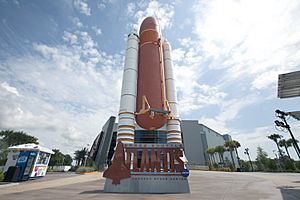
Your admission ticket includes a bus tour to Launch Complex 39 and other parts of KSC. It also includes entry to the Apollo/Saturn V Center. The United States Astronaut Hall of Fame used to be in a separate building. Now, that building is closed, and the U.S. Astronaut Hall of Fame is part of a new exhibit at the visitor complex called Heroes & Legends.
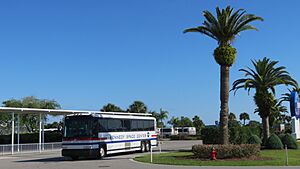
The Apollo/Saturn V Center is about 6 miles (9.7 km) north inside NASA's gates. It's a huge museum built around a restored Saturn V rocket. This center also has other space exhibits, including an Apollo capsule. Two theaters let you experience parts of the Apollo program. One theater makes you feel like you're in a control room during an Apollo launch. The other simulates the Apollo 11 Moon landing.
The Visitor Complex also has two facilities run by the Astronauts Memorial Foundation. The most famous is the Space Mirror Memorial. This huge black granite mirror has the names of all astronauts who died while on duty. The foundation also has the Center for Space Education, which helps teachers, and the Kurt H. Debus Conference Center.
Heroes & Legends replaced an older exhibit. It now holds the U.S. Astronaut Hall of Fame and many artifacts. You can see the Gemini 9A spacecraft there. There's also a recreated Mercury Control Center using real consoles from the original building. The original Mercury Mission Control building was taken down in 2010.
Space Shuttle Atlantis Exhibit
In 2010, the center announced a $100 million plan to display a retired Space Shuttle orbiter. On April 12, 2011, NASA announced that Space Shuttle Atlantis would come to the visitor center after its last flight on STS-135. The exhibit opened on June 29, 2013. It lets you see the shuttle from almost every angle. Atlantis is tilted at a 43.21-degree angle with its payload bay doors open. This is how it looked only when it was in space!
The exhibit also has a life-sized model of the Hubble Space Telescope. You can see the Shuttle program's astrovan and Dr. Maxime Faget's Shuttle prototype from 1969. There's a large slide that mimics the 22-degree slope of a Space Shuttle landing. You can also try astronaut training and Shuttle simulators. On the ground floor is the "Forever Remembered" exhibit. It honors the 14 astronauts lost in the Space Shuttle Challenger and Space Shuttle Columbia disasters. This exhibit includes personal items from the astronauts and pieces of the recovered Shuttles.
This exhibit replaced the Space Shuttle Explorer. That was a full-sized replica of the Space Shuttle that visitors could walk inside. Explorer was moved from KSC Visitor Center in 2011. It later went to the Space Center Houston.
Shuttle Launch Experience
The Shuttle Launch Experience opened on May 25, 2007. This attraction puts guests through a simulated Shuttle launch. Delaware North Companies spent six years and $60 million on this attraction. Astronauts, NASA experts, and attraction designers helped create it. The attraction is in a 44,000 sq ft (4,100 m2) building with four simulators. Each simulator holds 44 people. Former Shuttle commander and NASA Administrator Charles F. Bolden narrates the simulation. In 2013, this attraction became part of the Space Shuttle Atlantis exhibit. The former gift shop space now has simulators where guests can try landing and docking the Space Shuttle.
Heroes & Legends Exhibit
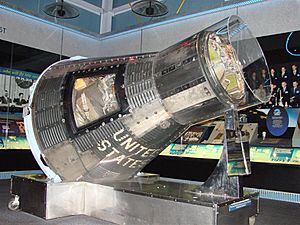
The United States Astronaut Hall of Fame is now inside Heroes & Legends. This exhibit opened in 2016 and cost $20 million. It focuses on America's first astronauts and what makes a hero. Each hero quality features astronaut items and videos. Key items include the 1966 Gemini 9A capsule. This capsule was flown by Thomas P. Stafford and Eugene Cernan. You can also see the original NASA emblem from the Mercury Control Center (1959). The control center from Project Mercury is also there. Other items include a Mercury Redstone rocket MR-6 and Wally Schirra's 1962 Sigma 7 capsule. There are also items from specific astronauts, like Gus Grissom's flight suit from July 21, 1961.
Heroes & Legends also has the U.S. Astronaut Hall of Fame. It displays the men and women who have been honored. In the middle of the hall, you can use an interactive screen. It has a database of inductees, a mission index, and a virtual photo chance with the Mercury 7 astronauts.
The Boeing company is the main sponsor of Heroes & Legends. This was the first time the visitor complex partnered with a company in over 50 years.
U.S. Astronaut Hall of Fame
The United States Astronaut Hall of Fame is inside the Heroes & Legends building. It's included with your daily ticket. The Hall of Fame used to be run by the U.S. Space Camp Foundation. Delaware North Park Services bought it in 2002 for NASA. The building was renamed the ATX Center. It now holds educational programs like Camp Kennedy Space Center and the Astronaut Training Experience.
Rocket Garden: A Collection of Space Giants
The Rocket Garden is right inside the main entrance, past Heroes & Legends. It's an outdoor display of historic rockets. These rockets helped put Americans and satellites into space. You can walk right up to and around the base of these rockets. All the rockets in the garden are real, except for the Mercury-Atlas, which is a replica.
The Mercury-Redstone, Mercury-Atlas, and Titan II rockets launched astronauts. The Juno I, Juno II, Thor-Delta, and Atlas-Agena rockets launched satellites from Cape Canaveral. These rockets stand upright. The largest rocket, a Saturn IB, is on its side. Saturn IB rockets launched Apollo Command/Service Modules into Earth orbit. They were also used for Skylab and the Apollo–Soyuz Test Project. The Saturn IB was restored in 2018. In March 2021, a Delta II rocket was added to the Rocket Garden.
The Juno I on display is painted with "UE." This refers to the rocket that launched the first U.S. satellite, Explorer 1. A Juno II launched the first American probe to escape Earth's gravity and fly past the Moon. Atlas-Agena rockets launched early probes to the Moon, Venus, and Mars. They also launched the Agena target vehicles used for rendezvous and docking by Gemini spacecraft. This technique was important for the Apollo missions. The Thor-Delta was a very reliable and often-used launch vehicle. The Titan II on display is a refurbished Air Force ICBM with a replica Gemini spacecraft. It looks like the Gemini 3 booster. It was saved from the Arizona Boneyard and put up in 2010. The Saturn IB on display is SA-209. It was planned for a possible Skylab Rescue mission.
The garden also has models of capsules from the Mercury, Gemini, and Apollo programs. Visitors can even get inside them. An F-1 rocket engine is also on display. This engine powered the first stage of the Saturn V. Free guided tours of the garden are available every day.
In June 2019, visitor complex official Therrin Protze offered to place a Falcon 9 or Falcon Heavy booster in the garden to SpaceX. SpaceX chief executive Elon Musk said he was interested.
Rocket Garden gallery
-
F-1 rocket engine for the Saturn V
Gateway: The Deep Space Launch Complex
This attraction, also called "The Deep Space Launch Complex," opened in the spring of 2022. It shows off equipment for future space exploration. You can see a Falcon Heavy booster and the Exploration Flight Test-1 capsule. There are also models of other spacecraft and interactive exhibits about trips beyond the Moon. The facility has three rotating shows about topics like planets outside our solar system, Mars, or new discoveries in deep space.
Apollo/Saturn V Center: A Giant Rocket Story
The Apollo/Saturn V Center (28°36′20″N 80°40′11″W / 28.6055°N 80.6696°W) is north of Launch Complex 39. You can only get there by bus tours from the main Visitor Complex. This center opened on December 17, 1996. It was designed to hold a restored Saturn V launch vehicle. It also has other exhibits about the Apollo program. Before this building was made, the Saturn V was displayed outdoors for many years.
The 100,000-square-foot building was built to house the Saturn V. Other exhibits include the Apollo 14 command module Kitty Hawk. This module carried Alan Shepard, Stuart Roosa, and Edgar Mitchell to the Moon in 1971. It orbited the Moon 34 times. Shepard and Mitchell made the third crewed lunar landing. You can also see an unused Apollo command and service module Skylab Rescue (CSM-119) and an unused Lunar Module (LM-9).
There's also a piece of Moon rock that visitors can touch. Other exhibits include a model of the Lunar Roving Vehicle. You can see different space suits, including Alan Shepard's Apollo 14 extravehicular suit. There's a piece of Apollo 13's Lunar Module that the astronauts brought back. You can also see Moon samples from Apollo 15 and Apollo 17. A large model of the Saturn V is also on display. Two theaters let visitors relive parts of the Apollo program. One simulates being in a control room during the launch of Apollo 8. The other simulates the Apollo 11 landing.
In January 2017, "Ad Astra Per Aspera – A Rough Road Leads to the Stars" opened in the Apollo/Saturn V Center. This exhibit honors the astronauts of Apollo 1 who lost their lives. It shows personal items from the three astronauts, with photos and videos. The exhibit also displays the charred Block I hatch from the fire. It also shows a redesigned Block II hatch. The Block II hatch flew on all later Apollo missions. It could open faster in an emergency.
Apollo/Saturn V Center gallery
-
Apollo 14 Command Module Kitty Hawk
-
Apollo Lunar Module (LM-9)
-
Lunar Roving Vehicle test car
-
The jacket worn by Michael Collins featuring patches for Apollo 11 and other missions he flew on.
Journey to Mars: Explorers Wanted
This attraction is now called Journey to Mars: Explorers Wanted. It focuses on exploring Mars. It uses large video screens, exhibits, and interactive experiences. It's designed to make visitors feel like they are part of future space exploration. The exhibit has simulators for orbital docking and lunar landing. You can see a full-sized model of a crew vehicle. There are also models of the Mars rover family: Curiosity, Spirit, Opportunity, and Sojourner.
NASA Now: Current Spacecraft
NASA Now is an exhibit that changes its display of spacecraft from NASA and its partners. As of summer 2017, NASA Now has the space-flown Orion EFT-1 capsule. This capsule was designed for NASA's Space Launch System (SLS). There is also a model of an SLS launch vehicle. You can also see a full-scale model of the Boeing CST-100 Starliner crew vehicle. SpaceX's space-flown Dragon capsule from COTS-2 is also featured. This was the first commercial vehicle to dock with the International Space Station (ISS). NASA Now is located inside the IMAX theater.
Space Mirror Memorial
The Space Mirror Memorial is also known as the Astronaut Memorial. It is located behind the IMAX theater at the main Visitor Complex. It honors NASA astronauts and other military and civilian astronauts who have died while on duty.
Planet Play: Fun for Younger Explorers
Planet Play is a multi-story play area for children aged 2-12. It opened on January 1, 2021. It has climbing structures, slides, interactive games, and light projections. The goal is to teach children about technologies used in space exploration.
Step. Power. Launch.
Step. Power. Launch. is an attraction where visitors jump on pressure pads. This powers up a rocket on a screen. There are three sections: Earth, Moon, and Mars. When the rocket is fully fueled, smoke comes from under the screen, and a launch sequence is shown.
IMAX Theater (Planet Play building)
This IMAX theater is inside the Planet Play building. It shows two films: Journey to Space and Asteroid Hunters.
Special Events and Programs
The Visitors Complex also hosts special events that require tickets. These are run by Delaware North. Naturalization ceremonies have been held in the Rocket Garden. You can also watch rocket launches from the visitor complex. These views are very close to the launch pads. The U.S. Astronaut Hall of Fame has a yearly induction ceremony. The Astronaut Training Experience is also offered. It has full-sized models of the Space Shuttle, Mission Control, and training equipment. The complex also runs week-long day camps for children in grades 2–9. The visitor complex offers events all year. These include astronaut presentations, signing opportunities, special guest appearances, and anniversary celebrations.
The music video for "Walking on the Moon" by The Police was filmed at the Kennedy Space Center on October 23, 1979. It shows the band members playing music among spacecraft displays. It also includes NASA footage. Stewart Copeland even hit his drumsticks on a Saturn V Moon rocket. Also, the music video for the 1992 Eurodance song "Rhythm is a Dancer" by Snap! was filmed at the Kennedy Space Center Visitor Complex's rocket garden.
More to See and Learn
- Air Force Space and Missile Museum
- Cape Canaveral Space Force Station
- United States Astronaut Hall of Fame
- Florida tourism industry



